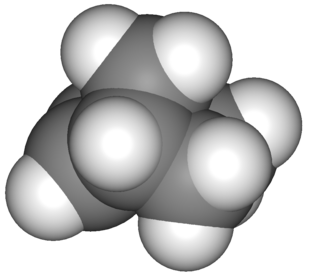Isobutane, also known as i-butane, 2-methylpropane or methylpropane, is a chemical compound with molecular formula HC(CH3)3. It is an isomer of butane. Isobutane is a colourless, odourless gas. It is the simplest alkane with a tertiary carbon atom. Isobutane is used as a precursor molecule in the petrochemical industry, for example in the synthesis of isooctane.

Alkylation is the transfer of an alkyl group from one molecule to another. The alkyl group may be transferred as an alkyl carbocation, a free radical, a carbanion or a carbene (or their equivalents). An alkyl group is a piece of a molecule with the general formula CnH2n+1, where n is the integer depicting the number of carbons linked together. For example, a methyl group (n = 1, CH3) is a fragment of a methane molecule (CH4). Alkylating agents use selective alkylation by adding the desired aliphatic carbon chain to the previously chosen starting molecule. This is one of many known chemical syntheses. Alkyl groups can also be removed in a process known as dealkylation. Alkylating agents are often classified according to their nucleophilic or electrophilic character.

2,2,4-Trimethylpentane, also known as isooctane or iso-octane, is an organic compound with the formula (CH3)3CCH2CH(CH3)2. It is one of several isomers of octane (C8H18). This particular isomer is the standard 100 point on the octane rating scale (the zero point is n-heptane). It is an important component of gasoline, frequently used in relatively large proportions to increase the knock resistance of the fuel.

Pentenes are alkenes with chemical formula C
5H
10. Each contains one double bond within its molecular structure. Six different compounds are in this class, differing from each other by whether the carbon atoms are attached linearly or in a branched structure, and whether the double bond has a cis or trans form.

Norbornene or norbornylene or norcamphene is a highly strained bridged cyclic hydrocarbon. It is a white solid with a pungent sour odor. The molecule consists of a cyclohexene ring with a methylene bridge between carbons 1 and 4. The molecule carries a double bond which induces significant ring strain and significant reactivity.

Cumene (isopropylbenzene) is an organic compound that is based on an aromatic hydrocarbon with an aliphatic substitution. It is a constituent of crude oil and refined fuels. It is a flammable colorless liquid that has a boiling point of 152 °C. Nearly all the cumene that is produced as a pure compound on an industrial scale is converted to cumene hydroperoxide, which is an intermediate in the synthesis of other industrially important chemicals, primarily phenol and acetone.
p-Cymene is a naturally occurring aromatic organic compound. It is classified as an alkylbenzene related to a monoterpene. Its structure consists of a benzene ring para-substituted with a methyl group and an isopropyl group. p-Cymene is insoluble in water, but miscible with organic solvents.

4-Nitroacetanilide is a chemical compound which is a nitro derivative of acetanilide. There are two other isomers of nitroacetanilide, 2-nitroacetanilide and 3-nitroacetanilide.
Dodecylbenzene is an organic compound with the formula C12H25C6H5.Dodecylbenzene is a colorless liquid with a weak oily odor. Floats on water.
Perfluoroethers are a class of organofluorine compound containing one or more ether functional group. In general these compounds are structurally analogous to the related hydrocarbon ethers, except for the distinctive properties of fluorocarbons.

Hexachlorobutadiene, Cl2C=C(Cl)C(Cl)=CCl2, is a colorless liquid at room temperature that has an odor similar to that of turpentine. It is a chlorinated aliphatic diene with niche applications but is most commonly used as a solvent for other chlorine-containing compounds.

N-Formylpiperidine is an organic compound with the formula C6H11NO. It is the amide of formic acid and piperidine. It can be used as a polar aprotic solvent, with better hydrocarbon solubility than other amide solvents such as dimethylformamide (DMF). It has also been used to transfer the formyl group to a Grignard reagent:

A benzopyrene is an organic compound with the formula C20H12. Structurally speaking, the colorless isomers of benzopyrene are pentacyclic hydrocarbons and are fusion products of pyrene and a phenylene group. Two isomeric species of benzopyrene are benzo[a]pyrene and the less common benzo[e]pyrene. They belong to the chemical class of polycyclic aromatic hydrocarbons.

Tripropylene, also known as propylene trimer, is usually sold as a mixture of structural isomers of nonene. This mixture is obtained by oligomerization of propene:

Propylbarbital, also known as 5,5-dipropylbarbituric acid, is a barbiturate derivative used as a hypnotic drug.

Alkylbenzene sulfonates are a class of anionic surfactants, consisting of a hydrophilic sulfonate head-group and a hydrophobic alkylbenzene tail-group. Along with sodium laureth sulfate they are one of the oldest and most widely used synthetic detergents and may be found in numerous personal-care products and household-care products . They were first introduced in the 1930s in the form of branched alkylbenzene sulfonates (BAS). However following environmental concerns these were replaced with linear alkylbenzene sulfonates (LAS) during the 1960s. Since then production has increased significantly from about 1 million tons in 1980, to around 3.5 million tons in 2016, making them most produced anionic surfactant after soaps.

2,4-Dimethylpentane is an alkane with the chemical formula [(H3C)2CH]2CH2. This colorless hydrocarbon is produced in large quantities in oil refineries. It results from the alkylation of isobutane by propylene. Often referred to as "alkylate", it is blended with other gasoline components to give a high octane fuel. Unlike n-heptane, 2,4-dimethylpentane is a desirable fuel because its branched structure allows combustion without knocking.

Neohexene is the organic compound with the formula (CH3)3CCH=CH2. It is a colorless liquid, with properties similar to other hexenes. It is a precursor to commercial synthetic musk perfumes.

o-Cymene is an organic compound classified as an aromatic hydrocarbon. Its structure consists of a benzene ring ortho-substituted with a methyl group and an isopropyl group. It is a flammable colorless liquid which is nearly insoluble in water but soluble in organic solvents.

Hemimellitic acid (benzene-1,2,3-tricarboxylic acid) is an organic compound with the molecular formula C6H3(СО2Н)3. Like the other isomers of benzenetricarboxylic acid, hemimellitic acid is a colorless solid. It is prepared by oxidation of 1,2,3-trimethylbenzene.

















